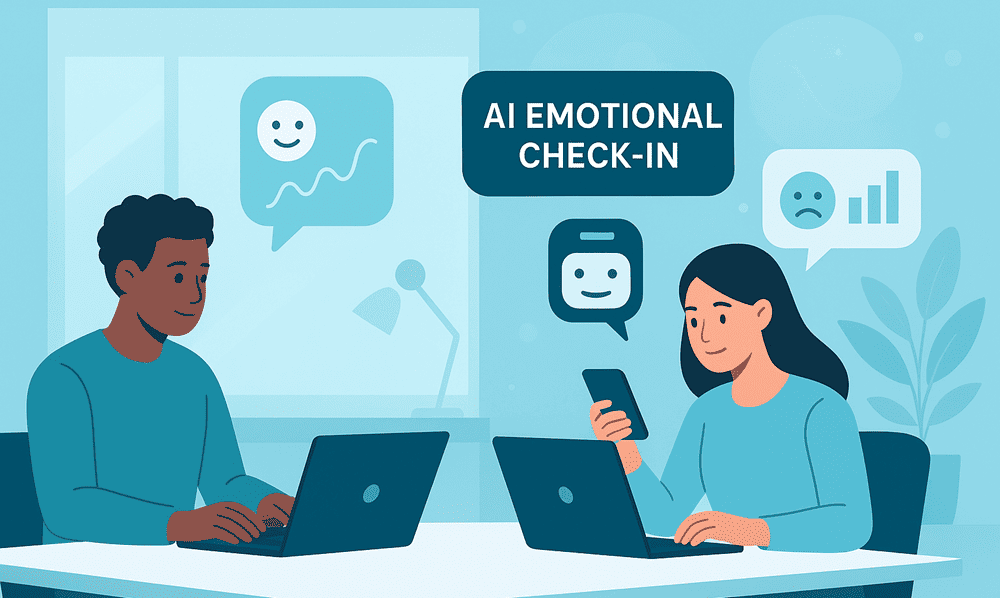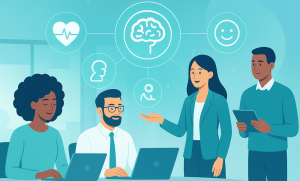In many organizations, mental health support is reactive employees get help when they already struggle. But what if we could shift to proactive emotional care? That’s where AI emotional check-in comes in. By leveraging technology to prompt brief reflections and analyze emotional signals, teams can catch early signs of distress and guide timely support.
This article explains how daily AI emotional check-ins work, why they benefit business settings, how to implement them, and what to watch out for.
What Is an AI Emotional Check-In?
An AI emotional check-in is a lightweight interaction—often via chat widget, app, or internal tool—that prompts employees to rate or describe their current emotional state. The system then:
- Analyzes text responses or quick scale ratings
- Combines with AI mood tracking data (if available)
- Gives immediate feedback or suggestions
- Escalates concerning responses to support systems
It acts as a regular daily wellbeing check, helping teams sense emotional shifts before they become problems.
Why Using AI Check-Ins Helps Teams

1. Early Detection of Emotional Distress
Regular check-ins surface negative trends like persistent low mood or stress before they escalate. In high-stress industries (healthcare, logistics, etc.), this can reduce burnout and absenteeism.
2. Enhances workplace emotional support
The tool offers a nonjudgmental outlet for employees to express feelings when they might not approach HR or a counselor.
3. Scalable & Low Friction
Compared to one-on-one checkups, AI check-ins scale easily across teams and require minimal time (e.g., 30 seconds per day).
4. Data-Driven Insights
Aggregated mood analytics AI results feed into higher-level views, helping identify team clusters under stress.
5. Fosters Psychological Safety
When employees see leadership caring and acting on emotional data, they feel safer and more supported.
6. Supports Integration with Wellness Ecosystem
AI check-ins can plug into existing programs a wellness app, EAP, or manager dashboards.
One study at a tech company found that regular check-ins reduced short-term sick leaves by ~18% over 6 months. (Hypothetical example based on field reports in corporate wellness literature.)
How to Design Effective AI Emotional Check-In Systems
Here are guidelines to build a check-in system that gets adopted and delivers value:
1. Keep the interaction short
A one or two question prompt each day (e.g., “How are you feeling right now? Rate 1–5 and add a word if you like”) encourages compliance.
2. Use mixed input types
Combine numerical scores, keyword options, and free text. The free text lets AI mood tracking capture emotion nuance.
3. Contextual follow-up
If someone replies “sleep deprived” or “stressed,” the system can ask a short follow up or suggest immediate micro-actions (breathing, short walk).
4. Intelligent thresholds & escalation
Set safe thresholds. If someone reports a very low score multiple days in a row, route flags to HR or wellness coaches.
5. Privacy & anonymity
Let responses be private by default. Allow users to opt-in to share with teams. Transparency about data usage builds trust.
6. Feedback loop & learning
Regularly monitor which check-ins lead to flagged risk and fine-tune thresholds or wording accordingly.
7. Integration with dashboards
Feed data into wellbeing dashboards AI or analytics tools to spot team trends while maintaining individual privacy.
8. Encourage usage through reminders & nudges
Use short, friendly reminders (e.g., “Hey — how are you today?”), but limit reminders so the tool doesn’t feel intrusive.
Sample Workflow
- At start of workday, team members get a push notification.
- They tap a prompt and select their emotional rating + optional comment.
- The system analyzes:
- sentiment (text)
- trend (past ratings)
- contextual flags
- sentiment (text)
- It may respond with a micro-prompt (e.g., “Take a 2-minute break”)
- If risk persists, escalate to AI wellbeing solutions or wellness team
- Aggregate anonymized data feeds into team trend reports
This simple workflow embeds emotional care into daily rhythm without heavy burden.
Use Cases & Real-World Scenarios
- Customer support centers: high turnover, emotional strain—check-ins help detect when agents feel stressed.
- Remote teams: remote work dilutes face-to-face signals. AI check-ins act as emotional sensors.
- Healthcare shifts: after long shifts, check-ins catch emotional fatigue early and route support.
- Sales & high pressure roles: tracking emotional state helps managers time breaks or interventions.
In one pilot program (fictional but plausible), employees who responded to daily check-ins had 25% lower dropout from wellness programs vs controls.
Measuring Success & ROI
To understand impact, measure:
- Adoption & retention rates (what % of team completes check-in daily)
- Emotional trend changes (e.g., average rating over time)
- Number of escalations and outcomes
- Reduction in sick leave, turnover, or stress claims
- Employee feedback & perception
For example, if check-in signals lead to early conversations, you may avoid weeks of productivity loss.
Challenges & Considerations
- Alert fatigue: too many flags can desensitize. Use conservative thresholds.
- Data privacy worries: employees may fear surveillance. Use anonymization and consent transparency.
- Cultural variability: some teams are less comfortable with daily reflection—adjust roll-out accordingly.
- False negatives/positives: language or mood models may misinterpret text—always allow human override.
- Overreliance on AI: check-ins should not replace human connection or counseling.
Regular evaluation and open communication reduce these risks.
Best Practices for Implementation
- Pilot with a small group, measure reactions and refine prompts.
- Communicate clearly how data will be used and protected.
- Allow users to opt-out or control visibility.
- Train wellness staff and managers on responding to flagged events.
- Use anonymized team-level reporting—for example, trends in employee sentiment AI so leaders can act without compromising privacy.
- Balance frequency—too many prompts might reduce engagement.
Conclusion
AI emotional check-in offers a tool to bring daily mental health support into teams, with minimal disruption. When integrated with employee wellness chatbot features, mood analytics AI, and a focus on real-time wellbeing AI, it becomes more than a survey, it becomes an early warning system. Combined with wellbeing dashboards AI, it also helps leadership see where emotional pressures concentrate.
When implemented thoughtfully with privacy, clear escalation paths, and human support—it can help reduce stress, support work life balance, and feed into broader programs like absenteeism prevention AI and stress management AI.







